Coronavirus (COVID-19): UK fiscal path – a new approach
This paper sets out ten principles the Scottish Government believes the UK Government should follow to support the UK economy and public finances as we begin to recover from the impacts of coronavirus.
Dealing with the debt overhang of households and businesses
It is not just government that is facing extremely high levels of debt due to COVID-19. The levels of indebtedness for businesses and some households, particularly those households at the lower end of the income distribution, are also elevated due to the impact of the pandemic on business cash flows and household incomes. The banks, as financial intermediaries, have an important role to play in mitigating businesses failures and in stemming a potential tide of defaults on household loans. The balance sheets of households, businesses, banks and governments are all inter-connected with, for example, liabilities on household and business balance sheets being assets on banks' balance sheets.
Businesses and households will need the support of the banking and financial system to recover from the crisis.
Our proposal: Agree a national debt plan to support businesses, households and the banking system through the economic recovery and manage debt recovery over a longer time period.
Households
Channels of impact
Early evidence suggests that the impact on households balance sheets has been different for high and low income families. The immediate impact on household balance sheets has been felt on those households at the lower end of the income distribution who have seen falls in income, particularly those who have lost their jobs. Many of these households were already in debt and many households do not have savings or assets to fall back on.
Analysis by the Resolution Foundation[18] finds that a typical worker in a shut-down sector, such as Wholesale and Retail, had average savings of just £1,900 per adult compared to £4,700 for households who have been able to work from home during the crisis. Households in distress will build up debt and can no longer afford to pay major monthly outgoings such as Council Tax and there is a risk that these may resort to high-cost credit to pay for essential goods. The results of a national financial impact tracker published by Standard Life Foundation show 50 per cent of UK households believe they will struggle to meet their financial commitments over the next three months. [19]
For other households the impact has been to decrease their household expenditure and this has led to increases in savings and household deposits (Chart 6).
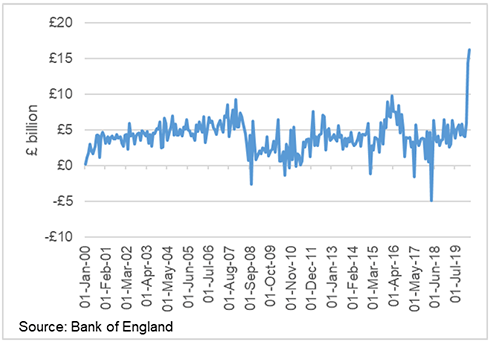
Chart 6 Description
A chart showing the monthly change in UK households’ bank deposits, since January 2000. There was a slight but sustained increase in monthly deposits, which peaked at 9 billion pounds in December 2007. During the Financial Crisis they decreased until they turned negative in October 2008. Following that, savings recovered their positive trend, albeit at a lower level than before the crisis. Most recently, there is an unprecedented increase to 15 billion pounds in monthly deposits during the lockdown period, as households could not spend.
Scale of debt
At the aggregate level, in March 2020, UK households' balance sheets were in a stronger position than prior to the global financial crisis. The share of households with a mortgage debt-servicing ratio at or above 40% — a level above which households are more likely to experience payment difficulties — has remained at around 1% over the past two years, compared to 2.7% in 2007, according to the NMG Consulting survey (Chart 7).[20]
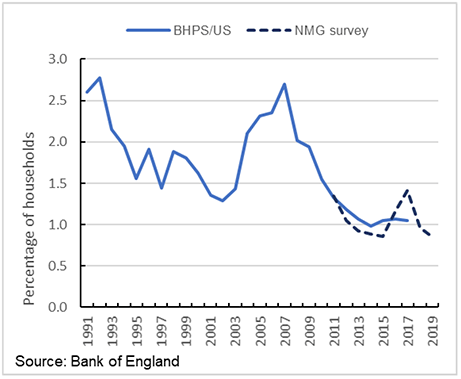
Chart 7 Description
A two-lined chart showing the percentage of households with a mortgage debt servicing ratio at or above 40%. The main line of the chart, with data for the period 1991 to 2017 from the British Household Panel Survey, shows that 2.7% of households had high mortgage debt servicing ratios in 1992 and in 2007. After 2007, the amount of households with mortgage debt servicing ratios of at least 40% decreased markedly, and stabilised at around 1% from 2013 onwards. The other line of the chart, a survey by NMG Consulting covering the period 2011 to 2019 only, shows a similar trend during these years but with an increase to 1.4% in 2017.
Although at the aggregate level, household balance sheets were in strong shape pre-crisis, there were already a significant number of households experiencing some financial difficulty — in terms of meeting payments or increasing demand for credit (Chart 8).
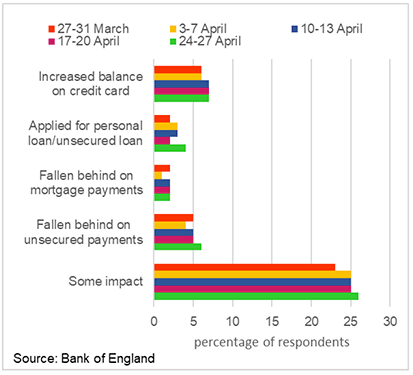
Chart 8 Description
A chart showing the proportion of individuals reporting missing payments or increasing demand for credit, over five different periods between the 27 of March and the 13 of April 2020. The chart reports responses over 5 weeks on issues such as increase in credit card balance, application to personal loans, falling behind mortgage payments, and falling behind unsecured payments. In almost every one of these aspects, the situation of respondents worsened as weeks went by. Overall, 23% of respondents reported some financial difficulty during the period 27 to 31 of March 2020, gradually increasing to 26% of them, during the period 24 to 27 of April.
Options for dealing with household debt
Current schemes have supported employment and household incomes and without them the share of highly indebted households would already have risen materially since the start of the pandemic.
Our proposal: Increase the responsiveness, accessibility, generosity of the UK welfare safety net, so that it provides sufficient support for people in and out of work.
For households at the lower end of the income distribution, there will be a growing need for effective welfare support and safety net programmes. The accessibility and generosity of welfare benefits is key. Although the UK Government has temporarily increased the standard allowance rate for Universal Credit, this does not go far enough nor does it help those who are in receipt of 'legacy benefits', such as Employment and Support Allowance or Jobseeker's Allowance, that have not seen any comparable uprating, and provision of housing support remains an issue for many. The UK Government should take the opportunity to address these known issues within the benefit system, along with others including removing the benefit cap, scrapping the two child limit and replacing debt inducing advance payments for Universal Credit with non-repayable hardship grants. These changes, combined with a concerted benefit uptake campaign, could ensure that those who are eligible for welfare support are willing and able to access it.
The Treasury could accelerate the introduction of a No-Interest Loan Scheme to target lower-income earners who cannot afford to repay interest on loans which at present has been announced as a pilot. This could help avoid households building up further debt.
For those households with assets such as mortgages, given that mortgages are lenders' largest loan exposure in aggregate, it is in the collective interest of the UK banking system to continue to support households through this period of disruption.[21] The continuation of payment holidays offered by lenders — for both mortgages and unsecured loan products — will be necessary, otherwise households may struggle to service their debt once the payment holiday measures end.[22] Should lenders opt to end payment holidays then it will be critical that they agree new payment plans with households in difficulties. The work of the Financial Conduct Authority will continue to be vital in driving creditors into offering payment holidays.
The package of measures on dealing with household debt should form part of a national debt plan.
Businesses
Channels of impact
In general, business balance sheets are currently weak as a result of shocks to cash flow. Government support schemes are offering grants and loans to maintain productive capacity by dissuading businesses from making redundancies or allowing capital to depreciate. However, some of these government support measures leave businesses with higher debts and businesses will need to find a way to transition away from such support in the longer term.
The level of indebtedness could limit future investment and growth of businesses. Moreover, the changing conditions and elevated uncertainty means that decision making within businesses will have changed to the extent that the COVID-19 'break-even point' is different and businesses are likely to exhibit a considerable degree of caution over major investment decisions, with a preference for stronger balance sheets and less debt.
Scale of debt
The uptake of Government loans schemes illustrates the scale of debt that has been accumulated. But the debt is not equally spread across the economy. The take up of the initial schemes was greater for large companies, as shown in Chart 9. This led to the introduction of the Bounce Back Loan scheme in May, which has significantly improved access to credit for many businesses. Different sectors have also been more affected than others, with the transport sector in particular seeing a large increase in loans, see Chart 10. This debt will need to be managed and repaid. We need to consider how companies can manage their debts.
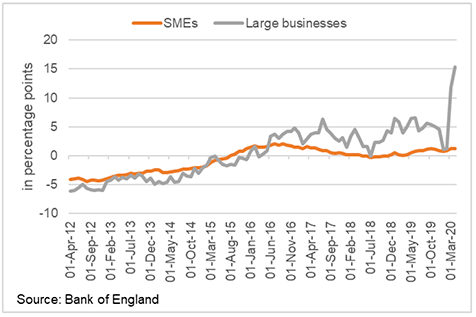
Chart 9 Description
A chart showing the annual growth rate of lending to businesses since 2012, until 2020 by size of business. Annual growth of lending to businesses, small and large, was similar and close to -5% in April 2012. It gradually recovered over time, and lending to small businesses became positive in September 2015, remaining close to 1% ever since. On the other hand, lending to large businesses only saw a positive trend in growth starting from April 2016, with a spike from around 1% in February 2020 to 15% in April. There has been no discernible impact on lending to small businesses.
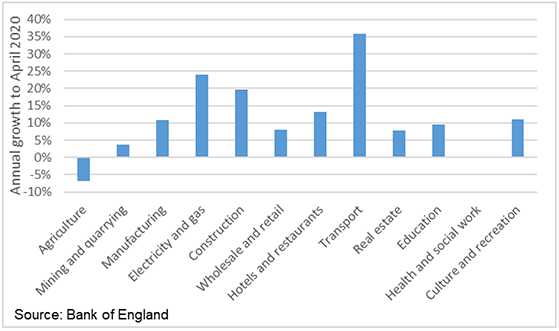
Chart 10 Description
A chart showing the annual growth in lending to large businesses by industry, in April 2020. Annual growth was largest in the Transport industry at 35%, followed by Manufacturing (25%) and Construction (20%). The only sector to see a decrease in lending was Agriculture.
The interim report by the Recapitalisation Group[23], led by TheCityUK and EY, suggests that the recapitalisation needs of UK small or medium sized enterprises (SMEs) are particularly acute, given the low volume of equity raised by SMEs (an average of £7.2bn p.a. from 2017 to 2019).
Options for dealing with business debt
It is not merely a question of managing down the debt of businesses. Many businesses will seek to take on additional debt, both to maintain their productive capacity and to build precautionary cash buffers. Continual supply of credit from the Banks will be key to supporting businesses.
For sectors with a longer recovery time – financial viability needs to change with a recognition that banks will need to continue some debt deferment and those sectors will need ongoing support.
Options for dealing with debt include:
- Transferring existing loans into patient capital fund, which could delay the point that interest repayments had to commence.
- Government support for strategic companies, transforming loans into equity investments.
- New sectoral banking products to meet the differential needs of sectors in the economy..
- Supporting SMEs by providing incentives to banks that increase lending to small and medium-sized enterprises.
- Transferring loans to a public policy bank, that could continue to support firms unable to manage commercial loans.
The package of measures on dealing with business debt should form part of a national debt plan. Further options for businesses lie primarily with the banking sector and are discussed in the next section.
Contact
Email: OCEABusiness@gov.scot
There is a problem
Thanks for your feedback